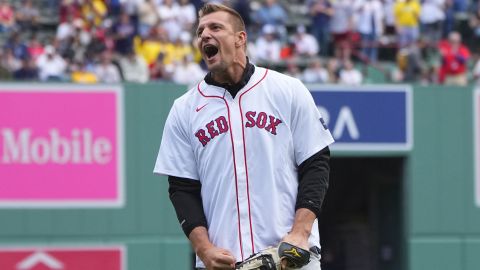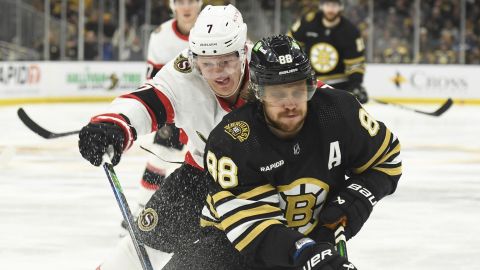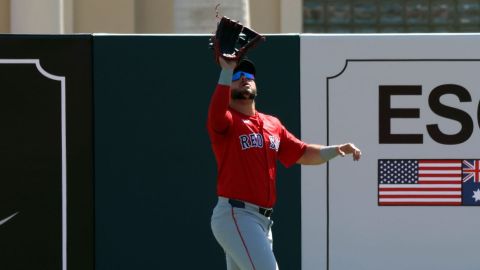 It’s clearly been a busy offseason for the Red Sox, and it’s not even Christmas. Yet, as they address their many glaring needs, the most glaring of all still stands out.
It’s clearly been a busy offseason for the Red Sox, and it’s not even Christmas. Yet, as they address their many glaring needs, the most glaring of all still stands out.
Sure, the Red Sox have added their power-hitting first baseman by agreeing to a three-year deal with Mike Napoli. They’ve also addressed the corner outfield situation by nabbing Shane Victorino and Jonny Gomes. They even added catching depth — you can never have too much — by signing veteran backstop David Ross to a two-year deal. They also re-signed David Ortiz, a move that should help shore up the middle of the lineup.
Just as importantly, all of the aforementioned guys are good clubhouse guys — players who will undoubtedly improve what has been a toxic clubhouse over the last two seasons. That’s a good sign, no doubt.
These things are seemingly good because they all address needs. Unfortunately for the Red Sox, though, none of those men pitch. That remains the biggest need, and it needs to be addressed if the Red Sox are really ready to turn things around.
More specifically, there is the need for starting pitching. It’s no secret that starting pitching is at a premium in baseball these days, more so than ever. Just look at the deal that Zack Greinke will get, wherever it is he may land.
You can also look to the past, too. It’s not a coincidence that last year’s playoff squads all had solid pitching staffs from top to bottom.
Here are how last year’s 10 playoff teams fared in their respective leagues in terms of ERA last season.
American League
Baltimore (6th)
Detroit (3rd)
New York (5th)
Oakland (2nd)
Texas (7th)
National League
Atlanta (4th)
Cincinnati (3rd)
San Francisco (5th)
St. Louis (6th)
Washington (1st)
The Red Sox, mind you, finished 12th in team ERA in the AL last season. They won 69 games. Again, no coincidence.
Theoretically, the Red Sox have already started to attempt to fix those big-time issues, without even inking or acquiring a legitimate big league starter yet. There are some who will tell you that Boston will see an improvement in its pitching with John Farrell returning to the Hub, this time as manager.
There’s obviously precedence for those types of thoughts. In his four years as pitching coach under Terry Francona in Boston, Farrell oversaw pitching staffs who had varying levels of success. Here are the Red Sox’ team ERA figures in those seasons (2007-2010) and how they ranked in the AL.
2007 — 3.87 (1st)
2008 — 4.01 (T-4th)
2009 — 4.35 (6th)
2010 — 4.20 (10th)
As you can see, things actually got worse throughout Farrell’s tenure. Did Farrell suddenly forget how to teach the art of pitching? No, of course not. Coaches and managers can only do so much. If there isn’t talent on the field, you’re not going to see the results. Now, there’s a good chance that Farrell will help guys like Jon Lester and Clay Buchholz get back to their form from those years — years where they posted better numbers than they have since Farrell left. But they can’t do it alone.
Unfortunately for the Red Sox, adding starting pitching isn’t that simple. If it were, every team would do it. In fact, there’s a very real possibility that the Sox are a year or two away from fully fixing that problem. The free-agent market is pretty thin in terms of pitching, especially after Greinke, who many think wouldn’t even be a good fit in Boston.
There are good young arms in the farm system — Matt Barnes and Allen Webster, to name a couple — but are they ready to make a significant big league impact this season? It’s unlikely. The future is bright, but you’re asking a lot of any of the pitching prospects in the Boston system to make a significant impact as a starter at the big league level this season.
There is always the chance of a trade, though. Reports out of the winter meetings indicate that just about anyone on the roster is in play for a potential trade, and there is always the chance that a blockbuster deal comes along. Does some team looking for an outfielder — looking at you, Philadelphia and Seattle — miss out on a big-name outfielder and get desperate to trade for someone like Jacoby Ellsbury? Or maybe some team looking to rebuild gets on the horn with Ben Cherington and offers a front-line starting pitcher for a package of Boston prospects.
Perhaps the most likely scenario — for this offseason, at least — is that the Sox add a middle-of-the-rotation arm or two. They likely think they have a No. 1 and 2 in Lester and Buchholz. Felix Doubront looks to be a solid part of the rotation moving forward, likely to man the back end of the rotation this season.
You also have to decide what you want to do with pitchers like Alfredo Aceves and Franklin Morales. If you think those names are unimpressive season-long rotation options, you’re probably not alone.
Then there’s John Lackey, who is the ultimate wild card. Even if Lackey does come back and isn’t horrible — which would be an upgrade from what he’s given the club in the last two seasons — there’s still the need to add another starting pitcher.
The Red Sox are making steps in the right direction. They’ve started to fix the problems they have, but there’s still that one really big problem remaining.




